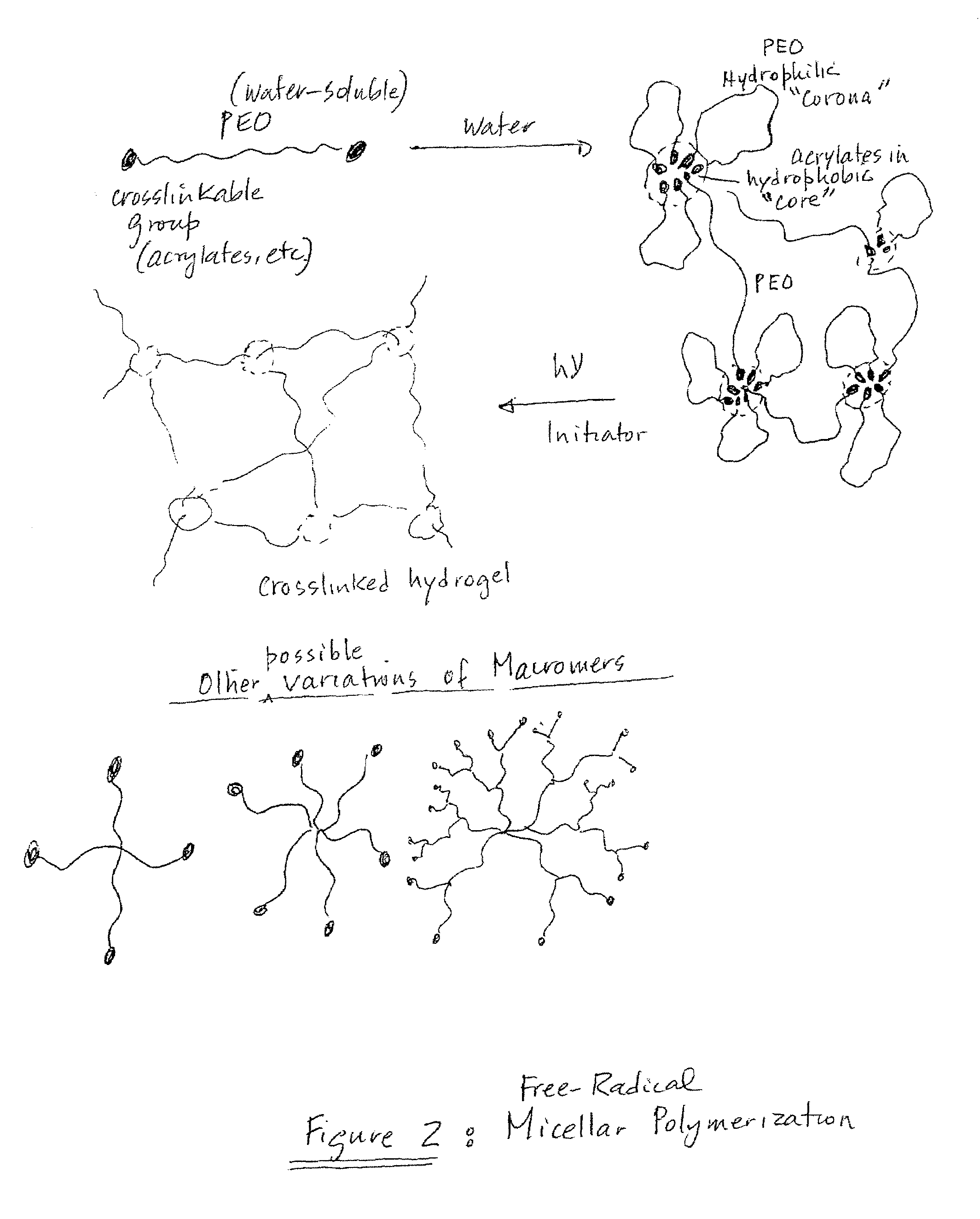Biocompatible chemically crosslinked hydrogels for glucose sensing
a biocompatible, chemically crosslinked technology, applied in biochemistry apparatus and processes, impression caps, dental prosthetics, etc., can solve the problems of pain and inconvenience of frequent and achieve the effect of improving sensor technology and improving continuous monitoring of blood glucose levels
- Summary
- Abstract
- Description
- Claims
- Application Information
AI Technical Summary
Benefits of technology
Problems solved by technology
Method used
Image
Examples
example 1
[0048]Hydrogels were prepared using 15% w / v PEGDA having a molecular weight of 3.4K. The hydrogels according to this example were formulated for optimal continuous monitoring of glucose and are capable of incorporating proteins and enzymes within the crosslinked gel matrix. In this example, glucose oxidase was incorporated within the gel matrix of the crosslinked hydrogel. Incorporation of glucose oxidase within the gel matrix of the crosslinked hydrogel was successfully achieved by appropriate selection of macromer, macromer concentration, appropriate levels of hydroquinone, extent of acrylation, intensity of light, and duration of photopolymerization.
[0049]A stock solution of 20% w / v glucose oxidase (“stock GOx”) was prepared by adding 200 mg of glucose oxidase (Aspergillus niger, Code GO3AC, Biozyme Laboratories, San Diego, Calif.) to a 4 ml glass scintillation vial and adding 800 μl of 10 mM phosphate buffered saline (PBS) solution via pipette. The 10 mM PBS having a pH of about...
example 2
[0057]The GOx in the 15% PEG-diacrylate hydrogels was quantitatively determined according to the following assay procedure. This assay can be used to determine the concentrations of GOx in the hydrogel that are effective or advantageous for transdermal glucose monitoring using the hydrogel.
[0058]A calibration curve for GOx was prepared. FIG. 3A shows an ultraviolet / visible wavelength (UV-VIS, approximately 200-900 nm) absorbance spectrum for 1% glucose oxidase in a phosphate buffered saline solution using a Perkin Elmer Lambda 6 UV / VIS spectrophotometer. As can be seen from FIG. 3A, glucose oxidase has an absorbance peak at about 450 nm. The GOx concentrations used in the calibration curve, FIG. 3B, were within the range of about 0-1% w / v (mg / ml). Specifically, solutions having a GOx concentration of 0%, 0.003%, 0.006%, 0.013%, 0.025%, 0.050%, 0.125%, 0.250%, 0.375%, 0.500%, 0.750%, 1.000%) were utilized to determine the level of detection (LOD), level of quantitation (LOQ) and rang...
example 3
[0064]The Gel Strength of a 15% PEGDA hydrogel was determined using the following techniques. “Gel Strength,” otherwise known as “Gel Modulus,” is a bulk property characteristic of chemically crosslinked networks that is demonstrative of the compressive, flexural and tensile strength of the bonds that comprise the network. Increases in concentration of the pre-polymer (PEGDA) can result in a higher network density, thus enhancing the overall gel strength of the hydrogel. While gel strength is typically measured by dynamical mechanical analysis (DMA), the method described herein involves a detailed qualitative scale for gel strength, expressed through compressive, tensile and flexural handling of the hydrogel.
[0065]The aspects of gel strength are defined as follows. Cohesive Strength is a measure of intermolecular bond strength, which is a molecular property. Flexural Strength is a bulk property defined by flexural stress over flexural strain. Flexural Strength relates impact resista...
PUM
| Property | Measurement | Unit |
|---|---|---|
| concentration | aaaaa | aaaaa |
| molecular weight | aaaaa | aaaaa |
| diameter | aaaaa | aaaaa |
Abstract
Description
Claims
Application Information
 Login to View More
Login to View More - R&D
- Intellectual Property
- Life Sciences
- Materials
- Tech Scout
- Unparalleled Data Quality
- Higher Quality Content
- 60% Fewer Hallucinations
Browse by: Latest US Patents, China's latest patents, Technical Efficacy Thesaurus, Application Domain, Technology Topic, Popular Technical Reports.
© 2025 PatSnap. All rights reserved.Legal|Privacy policy|Modern Slavery Act Transparency Statement|Sitemap|About US| Contact US: help@patsnap.com



